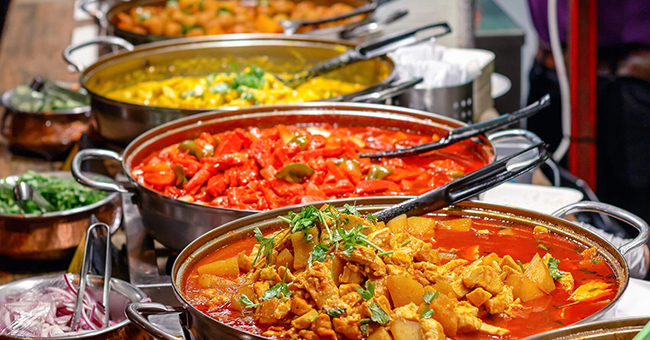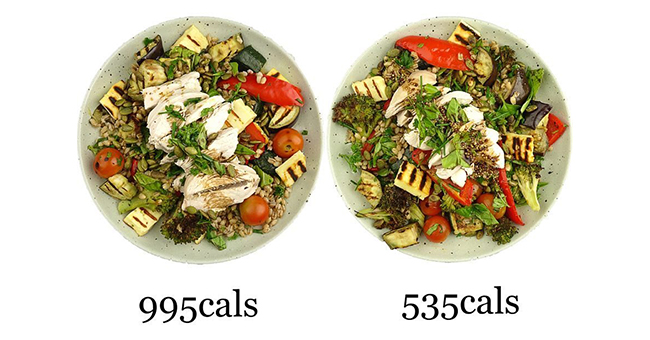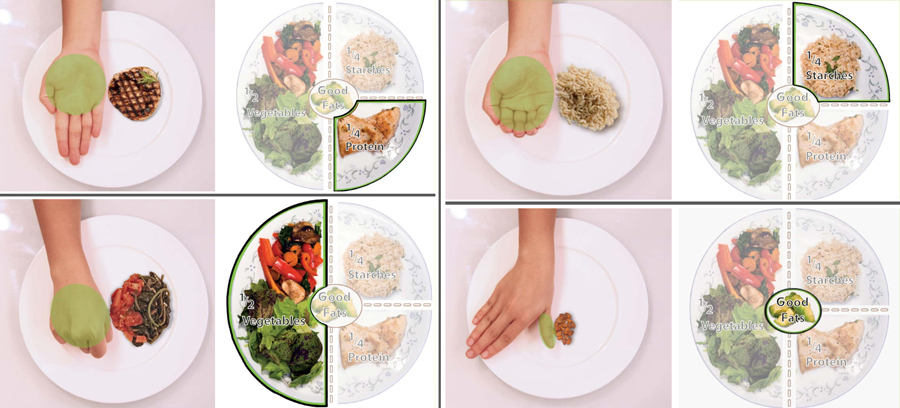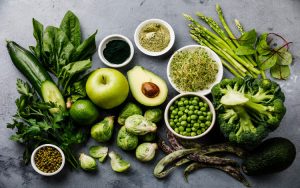Don’t we all love grabbing a quick, cheap and easy meal at a food hall, hawker centre or street stall? But eating out presents its own minefield when you want to eat healthy. While we may opt for a quick snack of popiah or have a side of sambal kangkong in an attempt to up our veggie intake and eat well, there really is no escaping the greasy, salt laden, high calorie traps of most dishes! Eating out is so ingrained in our culture that it would be social suicide to avoid all together, but there are better choices you can make at least some of the time.
So, allow us to help you navigate the eating out scene without breaking the healthy eating habits you’ve been working on. The solution – ditch and switch!
First, some great tips to remember when eating out:
✓ Remember your healthy plate portions for carbs, protein and fats (see image below)
✓ Don’t eat with your eyes! Portion size is one of the biggest saboteurs when it comes to weight loss.
✓ Try choosing wholegrain where possible – Think brown rice over white rice. Wholemeal bread over white bread. There is more nutritional value in wholegrains!
✓ Choose lean over fat – Think carefully about the fat content of your meats and avoid added fat of highly greasy dishes.
✓ Go easy on the gravy, sauce and dressings – There are so many hidden calories from sugar!
Now, that we have covered the basics. Let’s look at some of the biggest culinary culprits when it comes to misleading us…vegetable and salad dishes that are NOT really healthy choices when eating out.
Tempura any vegetable and it is a big fat temptation when eating out
This shouldn’t really come as a surprise. So, don’t try to utilise the old phrase ‘but I’m eating my vegetables’ as an excuse for this fatty temptation. Not only are the vegetables coated in layer of absorbent batter they are then deep fried, soaking up copious amounts of saturated fat.
Reality check – One 44 gram piece of eggplant tempura contains 118 calories and 10 grams fat (of which 5 grams are saturated).
Tip – Read the menu with care. Avoid items that are described using words like crispy, battered or deep-fried. Instead opt for dishes that are described as steamed, grilled, roasted or pan-fried.
But having Sambal Kangkong when eating out will give me my greens fix, right?!
There are so many great components to Sambal Kangkong that are completely undermined by the exorbitant fat content. The rich green water spinach leaves (alone) are a very low in calories, a great source of vitamin A and contain abundant levels of anti-oxidants. Chilli is also a great standalone spice. The spicy compound capsaicin has an anti-oxidant effects and benefits for your metabolism, often linked with weight loss. However, when it is processed into sambal and slathered across kangkong, this dish becomes more of a diet saboteur than a vegetable saviour.
Reality check – A typical 300g serving of sambal kangkong has 396 calories and is drowning in 39 grams of fat!
Tip – We understand that this favourite is hard to let go of completely. Attempt to share a dish of it, limiting your serving to a few spoonful’s. Or, let the sambal kangkong sit on some of your rice to soak up the excess oil. Just don’t eat the greasy rice afterwards!
Curry-in-a-hurry may quickly land on your hips

We love a good curry, but there are so many traps to choosing any curry vegetable dish when eating out! Knowing the impact of how the ‘good’ vegetable component weighs against the ‘bad’ gravy component all depends on the method of cooking. Without doubt though, the heavy use of oil, clarified butter, ghee and coconut milks will add up to a saucy amount of fat and calories. Most people under-estimate these details and consume more than necessary.
Reality check – A standard 1 cup serving of Indian vegetable korma will see you consuming 500 calories (that is without rice or naan). It has 12 grams of fat but can often be a lot higher depending on the amount of coconut cream used.
Tip – Ask for more vegetables and less of the curry gravy to be ladled into your serving. This may come at a slightly extra cost but your body will benefit from the increased vegetable intake and reduced calories. Also, opt for roti instead of white rice or naan as it has less calories.
Any vegetable that comes wrapped in a parcel, is NOT a gift!
Let me guess, you were thinking popiah, vegetable samosas or curry puffs are a healthy snack? Hmmmm, think again. Any vegetable that has been wrapped in a coating and fried, no matter how many alluring and beneficial spices are added, is not going to be a gift to your health. Samosas generally contain a high proportion of refined sugars and are fried in so much poor-quality fat that they are now considered a health warning and particularly dangerous for blood pressure, diabetes and obesity.
Reality check – One 70 gram vegetable samosa adds up to 156 calories, with 12 grams of fat.
Tip – Let’s be honest, the problem is, we rarely only have one samosa. Try being mindful about what is going to satisfy your hunger. One samosa is equivalent to almost three slices of bread, would you chow down on nine pieces of bread? Drink a glass of water before you decide on what you order!
Any salad when eating out is good for me though, right?!

Not all salads were created equal. Don’t misunderstand us, it’s not because of the salad itself. It is because of the salad dressing smothering it. Most of us are completely unaware that this lashing of dressing is where calories can explode, and the healthiness of the salad can be completely undermined. One of the most fun and flavorsome salads to eat out is Rojak. But don’t be fooled, it’s definitely not a healthy option. The individual components have health benefits beyond belief, think eye-health from pineapple and fibre from mango, but when you add the you tiao (fried dough) and coat it all in the sticky sweet dressing you enter the danger zone for other health problems.
Reality check – A small plate of rojak has 443 calories, with 20 grams of fat. That is equivalent to two chocolate frosted donuts!
Tip – Ask to have the rojak without the you tiao and go easy on the sauce. Better still, share a dish with a friend and opt for fresh fruit to finish your meal.
So, what should I eat then?
Eating well is not difficult. It starts with being mindful of what you consume. Stick to these simple thoughts -Clean eating. Wholefoods. Natural, unprocessed foods. Lean meat over fat. Grilled over fried. Easy on sauces and dressings. Then you add being mindful about your portion sizes.
We understand that eating out is part of how we live and would never expect you to completely sacrifice that valuable social time. The solution – follow Jaclyn’s tips, plus the tips above. Ditch and switch to healthier choices and options.
If you really want help, and want a pocket nutritionist, then download the Active8me app. There’re hundreds of healthy recipes for you to cook (Filipino, Thai, Chinese, Malay, Singaporean, Indian, as well as Western). Plus there’s a bunch of tools to help make eating out healthier. So, whether you are ‘eating-out’ or ‘dining at home’ we’ve got you covered!













